Key takeaways:
- Selective Mutism is an anxiety disorder in children that inhibits speech in unfamiliar situations, driven by fear and anxiety rather than mere shyness.
- Sharing experiences related to selective mutism can alleviate feelings of isolation and foster a supportive community, creating a tapestry of understanding.
- Raising awareness about selective mutism aids in reducing stigma, encourages community support, and promotes informed strategies within schools.
- Effective communication strategies, such as sharing personal stories in the right environment and using visual aids, enhance connection and understanding.

Understanding Selective Mutism
Selective Mutism is a complex anxiety disorder that primarily affects children, often causing them to be unable to speak in certain situations or environments, despite having the ability to communicate in comfortable settings. I remember a moment when my niece, typically full of laughter at family gatherings, suddenly clammed up at her first school assembly. Can you imagine the confusion when she wanted to join in but couldn’t find her voice?
This condition isn’t just about shyness; it’s rooted in profound fear and anxiety. For those who experience selective mutism, speaking in unfamiliar settings feels like standing on a stage in front of an audience, paralyzed by the spotlight. I often think about the emotional weight that must bear on a child who, despite wanting to connect, battles invisible barriers that hold them back.
Understanding selective mutism involves empathy and patience. It’s crucial for family members and educators to recognize that simply encouraging a child to “just speak up” might not work. Instead, creating a supportive and pressure-free environment can make all the difference. Reflecting on my own interactions with friends who’ve faced similar challenges, I realize how vital it is to foster trust, as it can lead to the gradual emergence of their voices.
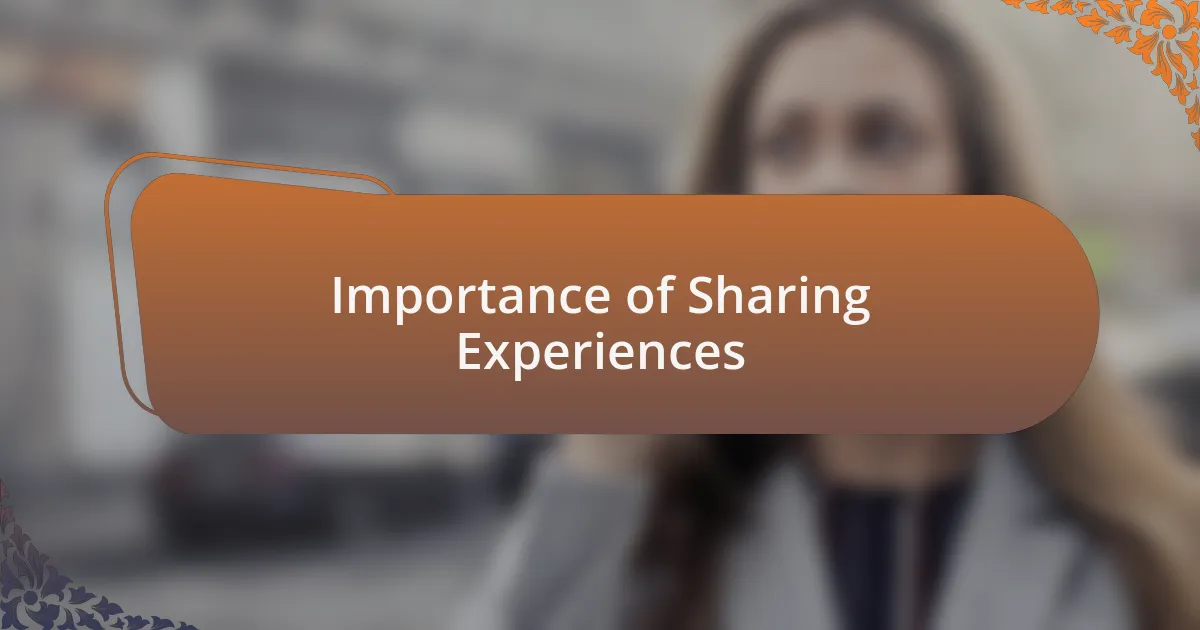
Importance of Sharing Experiences
Sharing experiences related to selective mutism is vital in breaking down the isolating walls that many individuals face. I remember when I first connected with a parent of a child who struggled to speak at school. Hearing their story felt like a light bulb moment; it underscored that no one is alone in this journey. It made me wonder, how powerful can these shared experiences be in helping us recognize that others are walking similar paths?
When we share our stories, we create a tapestry of understanding that wraps around those who feel isolated. I once attended a support group where different individuals opened up about their episodes with selective mutism. Each story, filled with heartache yet resilience, illustrated the complexities of this condition. It struck me how these narratives not only validated our struggles but also inspired hope in one another. Have you ever felt buoyed by hearing someone else’s experience echo your own?
Moreover, storytelling can serve as a powerful tool for advocacy. An instance that stands out to me was when I shared my experiences online, discussing the misunderstandings surrounding selective mutism. The feedback I received was overwhelming, with many expressing gratitude for shedding light on a topic they felt was often overlooked. It made me realize that by openly discussing our journeys, we can educate and empower others, opening new avenues for understanding and support.
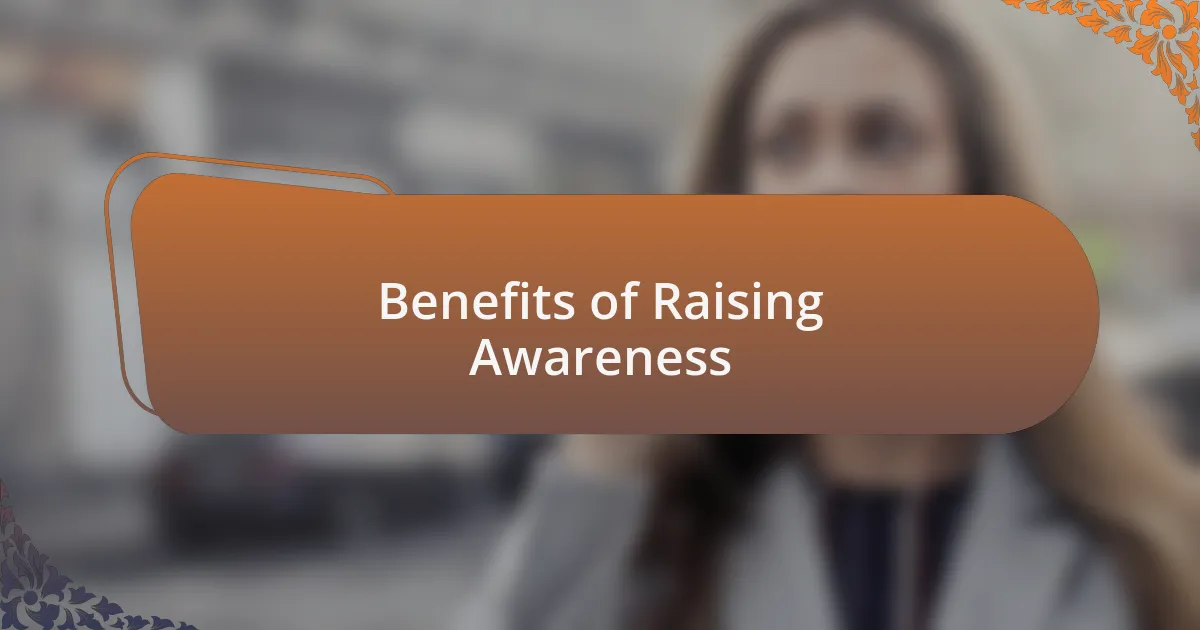
Benefits of Raising Awareness
Raising awareness about selective mutism can significantly reduce stigma and misunderstandings surrounding the condition. I recall a time at a community event when I explained selective mutism to a group of parents. Their expressions shifted from confusion to understanding, and that moment made me realize how awareness can pave the way for empathy and support. How often do we miss the chance to connect because we simply don’t understand each other’s experiences?
Another profound advantage of raising awareness lies in its ability to foster community support. I once participated in an online campaign aimed at sharing stories of those affected by selective mutism. The flurry of responses from others, many of whom shared similar challenges, reminded me that we’re all pieces of a larger puzzle. It was heartening to see how these connections create a sense of belonging and collective strength. Wouldn’t it be amazing if more people knew how impactful their stories could be for others?
Additionally, raising awareness can inspire proactive measures in schools and communities. I vividly remember a local school organizing a meeting to discuss how to better support students with selective mutism after I shared my own journey at a parents’ evening. The doors opened for teachers and staff to learn practical strategies tailored to assist these children. Imagine the ripple effect of such initiatives; when schools are educated, they become nurturing environments for all students.
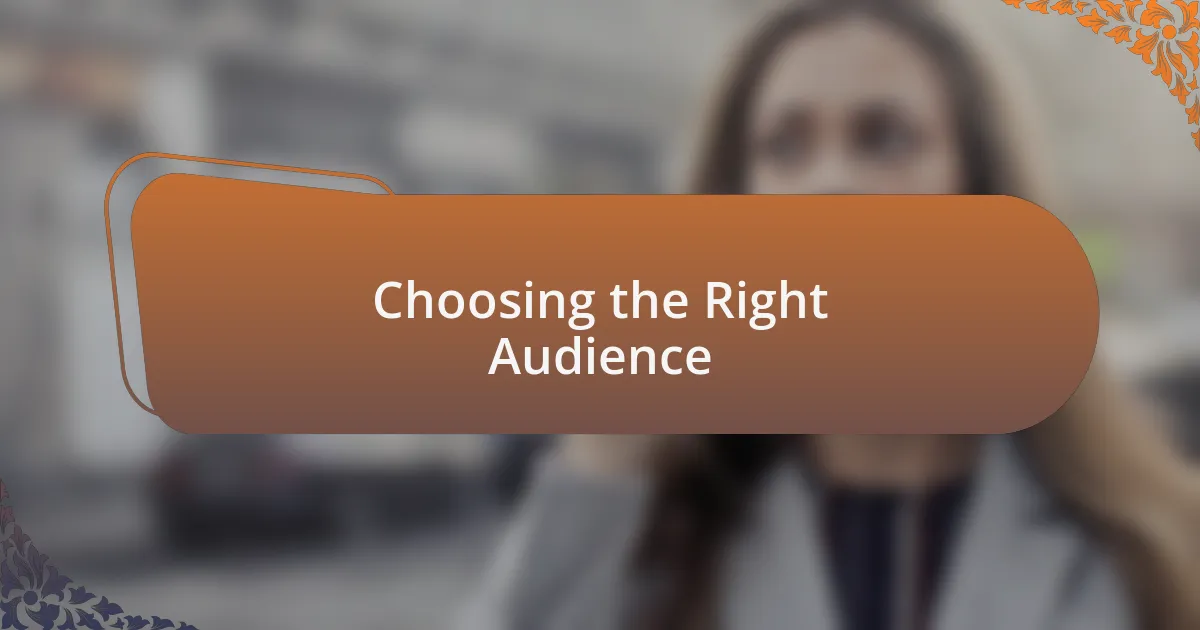
Choosing the Right Audience
When it comes to sharing my story, identifying the right audience is crucial. I’ve found that speaking to people who are genuinely interested often leads to more meaningful conversations. For instance, during a workshop aimed at mental health awareness, I noticed how receptive fellow attendees were when I shared my experiences with selective mutism. Their active engagement made it clear that the right setting can amplify the impact of my story.
Not everyone may understand or appreciate the nuances of selective mutism, and that’s okay. A year ago, I attempted to share my story with a large group unrelated to mental health issues, and the disconnect was palpable. Their lack of familiarity with the topic left me feeling unheard and frustrated. This experience taught me that selecting an audience that is compassionate and informed makes for a more rewarding exchange. Why waste energy on those who may not value the importance of my journey?
Being selective about my audience has opened doors to deeper connections. I can still remember a small gathering of friends where I felt safe enough to reveal my struggles. Their support and understanding were palpable, fostering a discussion that lasted long into the night. It was a reminder that when I choose to speak to individuals who are compassionate and curious, my story not only resonates more deeply but also paves the way for others to share their own journeys.
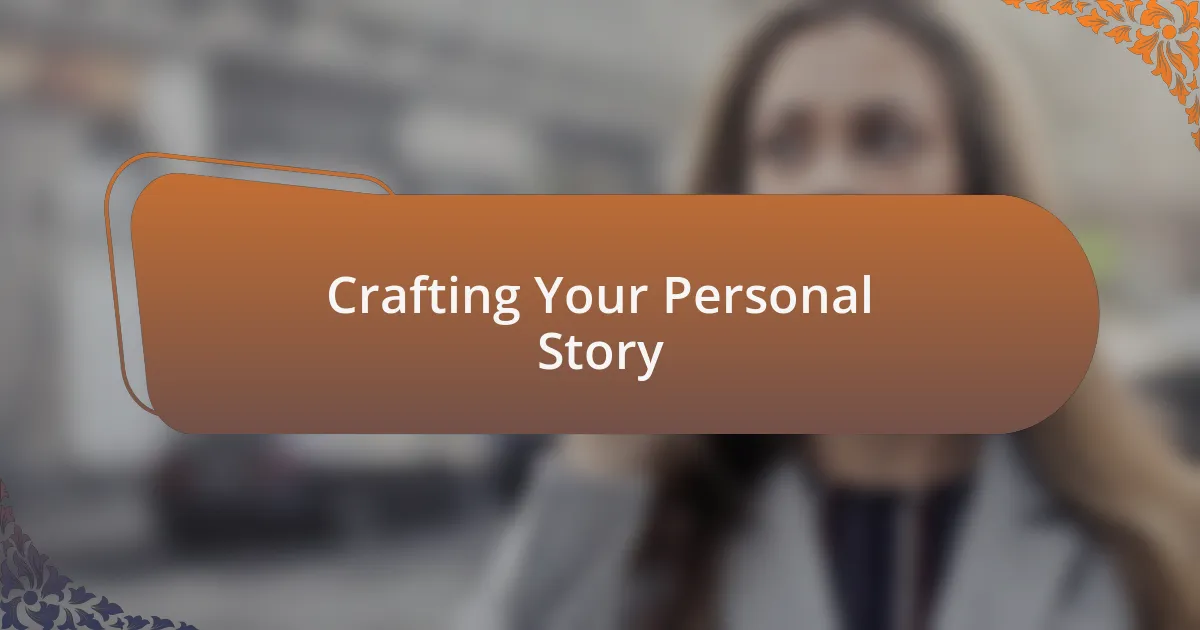
Crafting Your Personal Story
Crafting my personal story requires introspection and vulnerability. When I sat down to write my experiences with selective mutism, I wanted to capture not just the facts but the emotions behind them. I remember the first time I tried sharing my story—it was during a cozy coffee catch-up with a close friend. Her genuine curiosity made it easier for me to articulate feelings I had often bottled up. Have you ever found that in the right environment, words come out more freely, like a river finding its path?
As I shaped my narrative, I focused on pivotal moments that defined my journey. One particular instance stands out: I vividly recall the first time I chose to speak up in class after years of silence. The mix of fear and exhilaration was overwhelming, and sharing that moment of triumph can spark hope in someone else. By highlighting such critical experiences, I invite listeners into my world, helping them understand not just what I went through, but how it transformed me.
Ultimately, each story has unique threads that weave it together, and I believe my experience speaks to the heart of resilience. I often ask myself, “What do I want others to take away from my story?” This reflection helps refine my narrative into something relatable yet powerful. Whether I’m recounting a moment of struggle or a breakthrough, I aim to create an emotional connection that helps others feel less alone in their own battles. After all, sharing my story isn’t just about me—it’s a bridge to understanding and empathy.
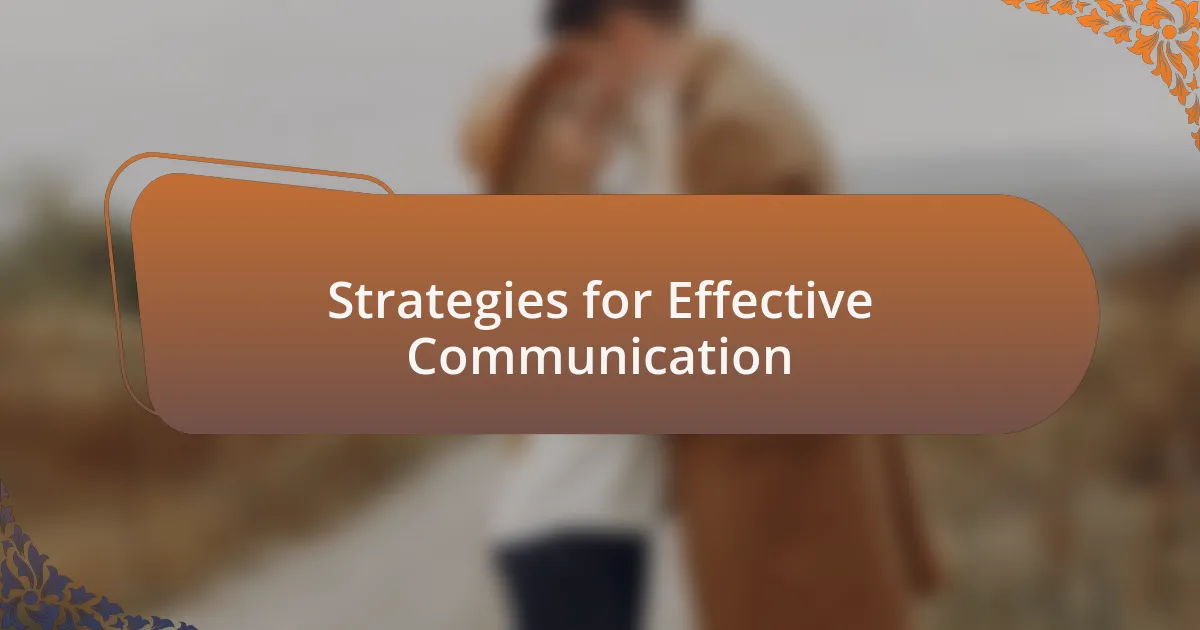
Strategies for Effective Communication
Finding effective communication strategies has been crucial in sharing my story. I often start by using visual aids or props that resonate with me—like a journal filled with notes from my journey. Holding that journal while talking can create a tangible connection. Have you ever noticed how visuals can spark conversation? They can make my experiences feel more relatable, grounding emotions in something physical.
Another technique that works for me is practicing my story beforehand with someone I trust. I remember standing in front of my mirror, rehearsing how to express my feelings. It felt a bit strange at first, but I quickly understood that this preparation helped reduce anxiety when the moment came to share. Sharing is a vulnerable act; how can we gear ourselves up for it without some practice?
Lastly, I pay attention to my body language and tone. I’ve realized that these non-verbal cues can convey as much meaning as my words. For instance, when I lean in and maintain eye contact, I invite others to engage on a deeper level. How does it feel to speak with someone who seems genuinely invested in what you’re saying? This awareness has transformed my interactions by enriching the dialogue, drawing others into my story more effectively.
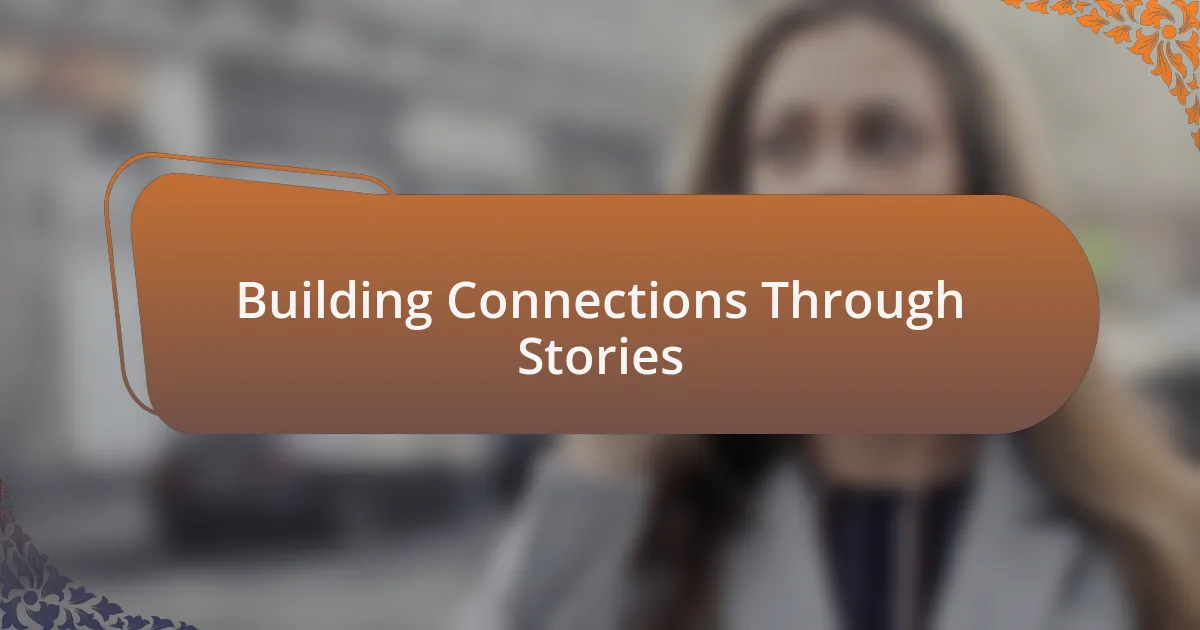
Building Connections Through Stories
Sharing our stories has an incredible power to forge connections. When I recount a moment that made me feel isolated due to selective mutism, I’ve often seen heads nodding in understanding. Have you ever shared a feeling so deeply that it felt like you were unveiling a hidden chapter of someone else’s life? Those shared experiences create a bridge, reminding us that we aren’t alone in our struggles.
I’ve found that vulnerability plays a significant role in building those connections. One time, I opened up about my struggles to a small group, and I could feel the atmosphere shift. It was like a wall crumbled, allowing others to share their own fears and challenges. When we dare to be vulnerable, how can we not expect others to reciprocate? It’s in these exchanges that bonds are strengthened and support networks begin to form.
Moreover, storytelling provides an opportunity to inspire empathy. I remember the first time I shared my story about a particularly difficult day at school. I watched as my classmates shifted in their seats, visibly moved. The impact of sharing the exact emotions I experienced truly resonated with them. Isn’t it amazing how one person’s story can ripple through a group, creating awareness and understanding? These moments remind me that sharing isn’t just personal; it’s a communal act that unites us in our shared humanity.